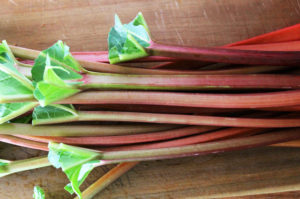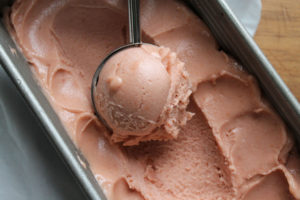Rhubarb: the red-headed stepchild of spring. If strawberries are the edible equivalent of Anne Boleyn, the fruit snack we all secretly want, then rhubarb is Catherine of Aragon. I felt that way for years until I saw the light. Now I appreciate rhubarb for what it is and hope to champion its qualities. And at any rate, we all know what happened to poor Anne, so who would want to be a strawberry anyway?
Rhubarb is a perennial that grows from rhizomes under the ground. Even though the stalks resemble celery, rhubarb is actually more closely related to buckwheat. (That is a fun fact to share at any social event, trust me.) The leaves of this plant are particularly beautiful, growing in a somewhat triangular shape, but they contain oxalic acid and should never be consumed. The stalks contain things I cannot pronounce (anthraquinones) that impart laxative properties, which may be the excuse you make when going for a second slice of granny’s rhubarb pie. Who needs to rely on pre and probiotics for regularity when there’s rhubarb for dessert?

Customers at the farmers markets often ask me, “What else can I make with rhubarb other than pie?!” There is always an air of frustration lingering around the question. I often picture people gifting rhubarb pies to their neighbors like they would fruitcakes at Christmas: a seasonal obligation that no one really enjoys giving or receiving. My first answer, “Make a crumble!” is often met with a look of mild disgust, unsure as to whether I’m actually trying to help or mock them. But I genuinely want to be of service, so I suggest jam or muffins — maybe a cake? I have a feeling barbecue sauce with rhubarb in it would be delicious. More often than not, folks reply, “I’ll just Google it.”
What I find the most interesting about rhubarb is it is not a true fruit and yet we treat it as such. Smothered in sugar, mixed with other fruits and baked under thick crumble crusts, we do everything possible to mask rhubarb’s intense tartness. But playing with that line between tart and sweet is half the fun. Some people don’t enjoy anything other than unadulterated sweetness in their desserts, but a light dose of lip pucker can actually add to the enjoyment of a treat. Like a sprinkle of salt on a chocolate chip cookie, an infusion of rhubarb can be the offset a good dessert needs. At the risk of sounding like every overpaid judge on The Food Network, rhubarb provides a counterpoint to sweetness and creates complexity.
From another standpoint, rhubarb is what we have right now, so bake with it. Every country cook I know will tell you that rhubarb is growing like a weed in her backyard and if you expect to be fed, be prepared to eat it. And that’s the perspective I appreciate most. If rhubarb is not overtaking your garden, Jade Family Farm and Jonas Beiler Family Farm can provide it for you at the Boalsburg Farmers Market on Tuesdays in the Military Museum parking lot from 2 – 6 p.m.
Truthfully, I think rhubarb really shines when it’s roasted, which comes as no surprise because roasting anything at a high temperature caramelizes the sugars and intensifies flavor. The roasting process softens the stalks well enough that they can be blitzed into a puree with ease. The texture becomes silky and incredibly jam-like, providing the ideal flavor base for an ice cream, sorbet or even a savory sauce. Rhubarb chicken barbecue sounds like a home-run to me. But pastry is in my heart, so I see sorbet in my future.
The recipe I’d like to share today checks all the boxes for me. It consists of a list of ingredients I can count on one hand, it won’t spoil quickly, it can be made with minimal effort and machines do all the hard work. I use a high-speed blender, but an immersion blender or even food processor will do the trick. And if you don’t have a fancy ice cream machine, pour the mixture into popsicle molds instead. If you don’t have popsicle molds, you actually do. They’re called paper cups and they work perfectly.

Roasted Rhubarb Sorbet
Makes 3 ½ – 4 cups
Adapted from Epicurious
Depending on the color of your rhubarb, the color of the sorbet will vary from blush to crimson. Also keep in mind that the more sugar you add, the less crystallized your sorbet will be. But even if you add the minimum amount of sugar, the addition of honey will soften the texture of the finished sorbet. You can use corn or brown rice syrup instead of honey.
Ingredients
1 ¼ lbs. rhubarb (1 large bunch)
⅓ – 1 c. sugar
1 c. water
1 Tbsp. lemon juice
2 Tbsp. honey
Method
Preheat oven to 400 F and position a rack in the center.
Clean the rhubarb, then remove and discard the leaves. Chop the stalks into 1-inch chunks and place on a clean baking sheet in a single layer. Roast the rhubarb for about 15-20 minutes, or until very soft. Remove and let cool slightly.
Add the rhubarb to a blender with ⅓ cup sugar, water, lemon juice and honey. Blend until smooth, then taste. If you prefer a sweeter mixture, add another ⅓ cup, blend, then taste again. Repeat once more for more sweetness. Transfer to a container and refrigerate for at least 6 hours. Place the bowl of the ice cream machine in the freezer to prepare for churning.
If using an automatic ice cream machine to churn the sorbet, follow the manufacturer’s instructions. When the sorbet is churned, enjoy immediately or transfer to a freezer-safe container to firm up before serving.


Yum! I love rhubarb in any way shape or form so I will definitely give this a try!